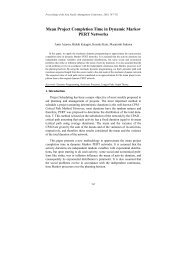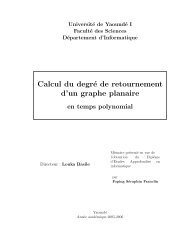Models for Global Constraint Applications - Cork Constraint ...
Models for Global Constraint Applications - Cork Constraint ...
Models for Global Constraint Applications - Cork Constraint ...
Create successful ePaper yourself
Turn your PDF publications into a flip-book with our unique Google optimized e-Paper software.
installed in a number of mills in the UK. This application was first described<br />
in [4], aspects of the model were discussed in [55].<br />
3.1 Problem<br />
Feed mills are large factories which produce hundreds of tons of products on<br />
a daily basis in a highly competitive market. Feed is produced locally, with<br />
farmers calling up the mill during the day and expecting a delivery on the next<br />
morning. They can select products from a large catalog, where each product<br />
type is highly specialised <strong>for</strong> a particular animal species. The product can either<br />
be a mixture of ground and treated raw materials (called meals) or is heated<br />
and put under pressure through a press, where the ingredients bond in <strong>for</strong>ms of<br />
cylindrical pellets or rolls of various sizes. The bill of material <strong>for</strong> one product<br />
may contain ten or more elements, some of which can be highly dangerous to<br />
other animal species.<br />
A typical layout of a feed mill is shown in figure 3, the flow of production is<br />
top down. Raw materials are stored in large bins from which they are drawn to<br />
a grinder/mixer, where a they are broken up and mixed with other ingredients.<br />
The resulting mixture can then either be used as a meal product or is temporarily<br />
stored in a number of pre-press bins. From there they are fed into the<br />
presses where, under pressure and temperature, the mix is <strong>for</strong>med into pellets<br />
and rolls.<br />
The size of the product is determined by the die size inside the press, which is<br />
part of the press configuration. Changing dies is a long and personnel intensive<br />
process (the dies weigh over a hundred kilograms), while changing from one<br />
product to another which uses the same die requires much less time.<br />
Not all products can be made on all presses, and some products have strong<br />
preferences <strong>for</strong> certain equipment, where particular pressure and temperature<br />
settings can be achieved. Machine throughput will depend on product and press<br />
combinations, and the length of production runs. The sequence of products on<br />
one press must be tightly controlled: We not only have to consider setup times,<br />
there are also <strong>for</strong>bidden or unwanted sequences. A <strong>for</strong>bidden step is when there<br />
is a contamination risk from the first to the second product. Some products<br />
(<strong>for</strong> example <strong>for</strong> pigs) are harmful <strong>for</strong> other species, to avoid a contamination<br />
risk we do not allow to follow them with feed <strong>for</strong> such species. For others, the<br />
temperature and press settings are so different that the quality of the product<br />
may suffer, creating more scrap material, and we try to avoid the sequence if<br />
possible.<br />
From the presses the finished product is fed through a system of conveyors<br />
and lifts into finished product bins, each holding many tons of product, or to<br />
movable tote bins of much smaller capacity. Not all connections from presses<br />
to bins are possible and/or preferred. The number and capacity of bins is not<br />
large enough to make products <strong>for</strong> stock, products are made to order and only<br />
stay in the bins until picked up or delivered to the customer.<br />
From the finished product bins there is another set of connections to the<br />
loading stations, where product is dumped directly into lorries, or to a bagging<br />
station, where smaller production runs are put into bags <strong>for</strong> delivery or<br />
distribution.<br />
Typical problem sizes are several hundred products, 30-50 raw material bins,<br />
2-3 mixers, 3-5 presses, 20-70 finished product bins, over 100 tote bins, and 2-5<br />
11









